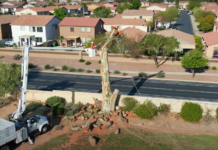The Pinal County Public Health Services District, Environmental Health Services would like to wish everyone a safe and happy holiday season. Holidays are times we share the kitchen with family and friends. With all the food being prepared as we celebrate, having leftover food is inevitable. Proper handling of leftover foods is one of the best things you can do to keep your family and friends safe from food-borne illness.
Put Foods Away Promptly
While everyone is busy celebrating, it is very easy to overlook the foods sitting on the counter or on the dinner table. Everyone is stuffed from their holiday meal and it can be difficult to find motivation to clean up. Also, there is a lot of temptation to leave foods out so we can nibble on them or so they may be available for guests who arrive late. The one thing that should be prioritized after the meal is to put the foods away. The “danger zone” is between 41°F and 135°F – the temperature range where food-borne bacteria multiply rapidly. The time that food sits on the counter should be minimized and certainly should not exceed two hours. Be sure your refrigerator holds a temperature at or below 41°F.
Safe Cooling
A lot of us assume that once food is put into the refrigerator that it is safe. Even after you put foods into the refrigerator it can still stay in the temperature danger zone for a significant period of time – allowing bacteria to multiply. Cooling the food down rapidly is very important to prevent illness. Here are a few hints to help you cool down your foods rapidly. 1) Keep the portion sizes small. Try to limit the depth of leftover foods to less than four inches. Realize that the outside of the food will cool first, but it can still take quite a while for the interior to cool down. 2) Keep the food uncovered until it is cold. This allows the cold air to flow across the surface of the food. The air flow is just as important as the temperature in cooling foods down. 3) Don’t overload your refrigerator. Ensure there is adequate space to allow for air to circulate around cooling foods. 4) Don’t hesitate to check food temperatures in your refrigerator after an hour or two to ensure that the food is cooling down rapidly.
Safe Reheating
Reheating is another important step in handling leftover foods. Use a food thermometer to ensure that leftovers are thoroughly heated. Make sure the food reaches a safe minimum internal temperature of 165°F. Bacteria can survive in leftovers that have not reached 165°F, possibly resulting in food-borne illness. Also, keep in mind that if foods are left in the temperature danger zone too long, even reheating them thoroughly may not be enough to ensure the food will not cause an illness.
Use Leftovers Quickly
Use your leftovers promptly. They should either be eaten or frozen for later use within about four days. Incorporate your holiday leftovers into your meal plans and recipes. Some of the best parts of a holiday turkey are the turkey sandwiches, turkey soup, and turkey ‘al-la-king’ that many of us enjoy in the days after the main meal. As soon as you know you won’t have an immediate use for leftovers, put them in the freezer for later use. Frozen food will keep for much longer than refrigerated foods.
If In Doubt, Throw It Out
If you ever have any reason to feel that your food is not safe don’t hesitate to throw it away. The issues that cause disease in foods, such as bacteria, viruses, and toxins, are not always apparent. They are typically colorless and odorless. Keep this food safety saying in mind, ‘If in doubt, throw it out!”
The Pinal County Public Health Services District has a goal to prevent disease, promote health, and provide nutrition services to the residents of Pinal County. Environmental Health Services conducts inspections of permitted facilities, monitors the community for disease vectors, and investigates public health nuisance complaints. If you would like more information on our programs, or to file a complaint, please visit our webpage at http://pinalcountyaz.gov/ehs or call 866-287-0209.



![Shred-A-Thon to take place tomorrow An image of shredded paper. [Pixabay]](https://www.inmaricopa.com/wp-content/uploads/2024/03/shredded-paper-168650_1280-218x150.jpg)
![Elena Trails releases home renderings An image of one of 56 elevation renderings submitted to Maricopa's planning department for the Elena Trails subdivison. The developer plans to construct 14 different floor plans, with four elevation styles per plan. [City of Maricopa]](https://www.inmaricopa.com/wp-content/uploads/2024/04/city-041724-elena-trails-rendering-218x150.jpg)
![Affordable apartments planned near ‘Restaurant Row’ A blue square highlights the area of the proposed affordable housing development and "Restaurant Row" sitting south of city hall and the Maricopa Police Department. Preliminary architectural drawings were not yet available. [City of Maricopa]](https://www.inmaricopa.com/wp-content/uploads/2024/04/041724-affordable-housing-project-restaurant-row-218x150.jpg)











![Shred-A-Thon to take place tomorrow An image of shredded paper. [Pixabay]](https://www.inmaricopa.com/wp-content/uploads/2024/03/shredded-paper-168650_1280-100x70.jpg)
